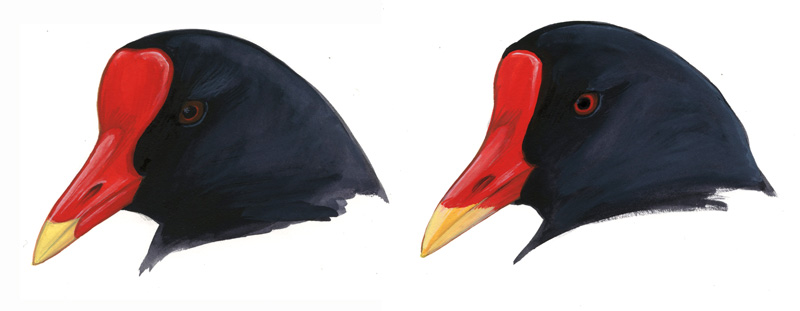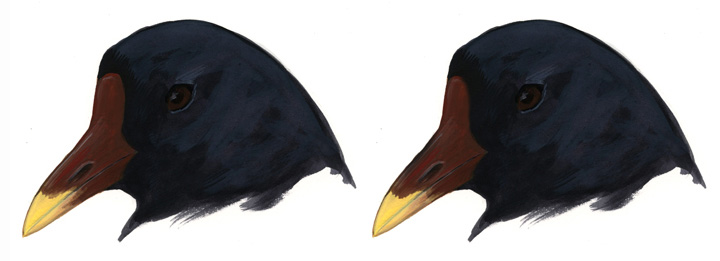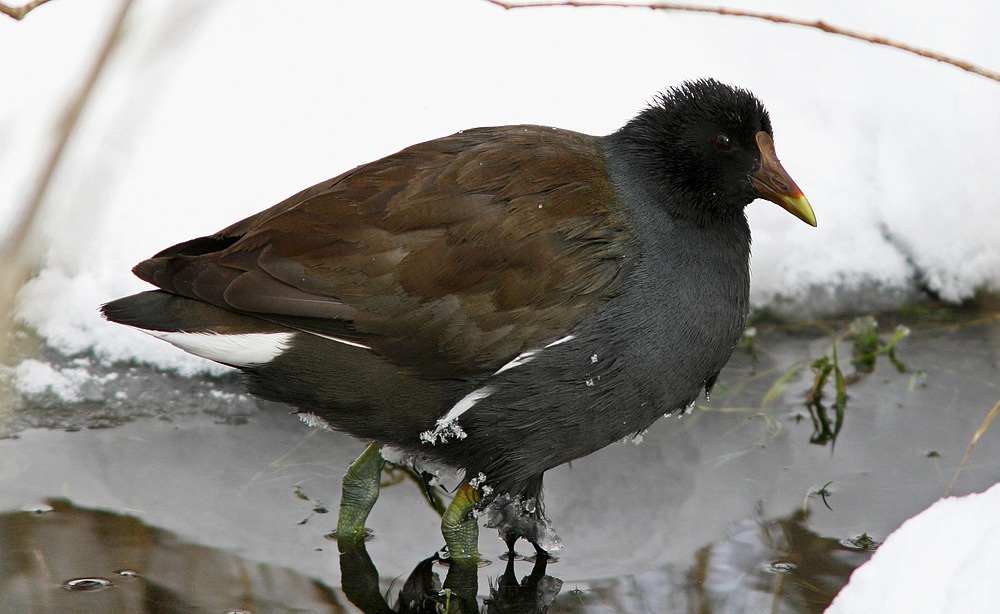Maybe, it depends how sure you want to be.
Update July 2011 – See my new post on Back color of Moorhens for an additional clue to identification

Recent talk of splitting Common Moorhen into two species – American and Eurasian – has naturally sparked interest in their identification (the split is based largely on differences in voice first described by Mark Constantine et al in The Sound Approach to Birding, the split is also discussed here). It seems an unlikely species to cross the ocean, but it is in the rail family, and many rails are famous for their far-flung adventures.

By strange coincidence, not long after discussion of the potential split began in fall 2010, a moorhen showed up on Shemya Island in the western Aleutians – a first for the state of Alaska. That bird was in first-winter plumage and may not be identifiable by appearance, but strictly on geographic probability it is almost certainly a Eurasian moorhen and thus the first for North America. It is now a specimen so confirmation of its identity will surely come in the form of DNA tests.
By further coincidence, a moorhen was found in eastern Newfoundland in Feb 2011, one of very few records there. Other vagrants found nearby around the same time include several Northern Lapwings, several Redwings, a Chaffinch, and other European vagrants. So this bird also has at least the potential to be a Eurasian Moorhen, and I set out to try to figure out if it was.

Bill tip pattern
European birds have more yellow on the lower mandible, so the boundary between red base and yellow tip forms a straight line angled back across both mandibles (vs American with a triangular wedge of yellow extending back along the cutting edge). This is fairly consistent in photos, but a few Eurasian birds seem to approach the American pattern, and according to a photo review by Jochen about 30% of European birds resemble the American V-shaped pattern. It is even less useful in drabber birds, which have a poorly-defined pattern on the bill and seem more variable.
Shield size
American birds in full breeding condition have a larger and broader frontal shield, flat or even notched at the top, but since this is related to age and season, these birds pass through stages of development very similar to the Eurasian birds. It’s a somewhat useful one-way feature – birds with very large and broad shields are likely to be American. Jochen (link here) reviewed photos of European birds and further refines this to suggest that only birds with large shields notched at the top are safely identified as American.
Shield size and color is controlled by testosterone (Eens et al, 2000), and can change seasonally, becoming smaller and duller in nonbreeeding condition, mainly in Aug-Oct while birds are molting (P. Pyle, pers.comm.). Some or most adults show a bright red shield through the winter, while the shield on others may remain smaller and drabber in winter. The degree of fading and the percentage of adults showing a bright red bill in winter are poorly known and deserve more research.
Immatures gradually develop the adult shield shape and color through their first winter. Brighter ones probably overlap with the drabbest adults and therefore determining age can be difficult. Even in summer, many American birds (probably females) have a smaller red shield like Eurasian, and occasional Eurasian birds in summer can have a shield as large and broad as American.
Eye color
Eye color is often bright red in adult Eurasian, darker maroon or reddish-brown in adult American, and dark drab brown in immatures. As first-winter birds gradually develop adult eye color, Eurasian birds will presumably pass through a reddish-brown stage very similar to adult American. Jochen reports that among photos or European birds many show dark brown eyes similar to American, so eye color is not very useful. In any case the differences are small and eye color is notoriously unreliable for bird identification. For example, a red-eyed moorhen in North America should be checked carefully, but will probably turn out to be a variant of the local population rather than a vagrant from afar.
Leg color
Strangely, Bannor et al. (2002) report that American moorhens (at least in Florida) have little or no scarlet on the upper part of the leg, while Eurasian birds show obvious scarlet there. Browsing photos from both regions, however, suggests the opposite: red is more likely to be shown by American moorhens than Eurasian. Regardless of which is more likely to show red, it is clear that both can and this is not a useful field mark.
The Newfoundland bird

Identifying the Newfoundland moorhen proved a much greater challenge than I anticipated. I ruled out eye color, shield size, leg color, plumage, and other features as too variable to be useful on a subadult. Eventually, after studying many photos and corresponding with Killian Mullarney about the birds he was currently seeing in Ireland, I settled on the pattern of the lower mandible as the only potentially useful feature. This mirrors the pattern on adults, but is more difficult to discern since immatures have drabber bills with less well-defined patterns. The Newfoundland bird shows a vague bill pattern that seems closer to an American moorhen, so that is where this investigation points.
Summary:
- Adults with mostly yellow lower mandibles might safely be identifed as Eurasian.
- Adults (bright red bills) with limited yellow on the lower mandible are likely American.
- A large and flat-topped shield is an indication of American.
- Birds with bright red eyes are likely Eurasian.
- Seriously, the easiest way to identify a silent or subadult moorhen might be to find a dropped feather and send it away for DNA testing.
This is just the beginning of an effort to figure out how to identify these birds. There is sitll lots to be learned and hopefully someday a better understanding of variation in moorhens will allow us to identify them with more confidence, and maybe even to tackle the challenge of identfying them in juvenal plumage.
References
Bannor, Brett K. and Erik Kiviat. 2002. Common Moorhen (Gallinula chloropus), The Birds of North America Online (A. Poole, Ed.). Ithaca: Cornell Lab of Ornithology; Retrieved from the Birds of North America Online: http://bna.birds.cornell.edu/bna/species/685
Constantine, M., and The Sound Approach. 2006. The Sound Approach to birding: A guide to understanding bird sound. http://www.soundapproach.co.uk/books/sound_approach.php
Eens, M., E. Van Duyse, L. Berghman and R. Pinxten. 2000. Shield Characteristics Are Testosterone-Dependent in Both Male and Female Moorhens. Hormones and Behavior, Volume 37: 126-134
Jochen. 2011. Blog post: Remarks on the identification of American and Eurasian Moorhens. http://birderhyde.blogspot.com/2011/02/remarks-on-identification-of-american.html
There are a few more photos of the Newfoundland bird on Dave Brown’s blog here: http://birdingnewfoundland.blogspot.com/2011/02/making-sense-of-moorhens.html
and some by Gene Herzberg here http://www.flickr.com/photos/geneherz/5419589336
Thanks to Killian Mullarney, Peter Pyle, Bruce MacTavish, Jared Clarke, and Dave Brown for helpful discussion and photos.


Thanks to Jared Clarke for sending this additional info about the Newfoundland bird:
This was interesting to me, as I visited Grenada (in the West Indies) some six years ago. Then, I was struck by how different the shield colour of the Moorhens appeared: it was somehow brighter and more vibrant than that of European birds. In addition, despite not being able to secure close views (they were quite shy of humans and the other side of a lagoon), the shield did seem to be of a subtly different shape.
At the time, I attributed some of this to either the (definitely!) more intense sunlight than is usual in the UK or, possibly, colouration from food.
However, bearing in mind the above comments (2000) on testosterone, which I haven’t been able to read, there may be this other cause.
I cannot recall being similarly struck by the shields of American Moorhens, in my four trips to the US. But, in Texas this April, I will look much more closely.
Hi David, I have several photo of a Common Moorhen on my website starting with this image:http://tinyurl.com/48kmz7l
I took those photos in early June in Germany last year. I see a subtle difference in bill pattern; the shield is obviously narrower; the eye color however is not red. I am not sure whether this helps.
Dear David,
I read your post with great interest and analysed a few pictures of European birds according to your suggested field characters. Here is a small write-up of my thoughts:
http://birderhyde.blogspot.com/2011/02/remarks-on-identification-of-american.html
Cheers,
Jochen
Jochen, Thanks very much for taking the time to check this out. I’ll update the post above with the results of your study. I’m preparing myself for the possibility that there may be no visual feature that distinguishes these two populations all of the time, and identification may have to rest on vocalizations (or DNA). So far, I think only the breeding season calls of adults have been studied, and it’s worth checking the short clucks and groans given by immatures and non-breeders to see if there may be differences there.
A bit off topic, but this paper has some info on responses (or lack thereof) of Hawaiian moorhen to American moorhen calls (vs comparisons to con-subspecific calls):
http://www.daltonstate.edu/faculty-staff/ddesrochers/pdf/Hawaiian.Moorhen-Call-broadcast.surveys.pdf
I live on a lake in Winter Haven,Fl and have two pairs of moorhens. There is a pair with the orange beak that goes up between the eyes. The other pair have the orange beak that has blue that goes between the eyes and are more colorful. The reason I am curious is I can’t find any pictures of them on these internet. This pair also comes up to me and eats out of my hand and comes into the patio.
Pingback: Accelerating | Cape Sable Birding
Pingback: 10,000 Birds | Common Moorhens at Hannover Zoo